all photos sourced from the Fat Liberation Archive
Rose Gelfand and I both found FaT GiRL by accident.
I came across an old cover while scrolling through Instagram, shared by the Chicago-based Gerber/Hart Library & Archives, she as a student at Scripps College, via a mention in the footnotes to “the seminal fat queer zine” in an article she was reading.

Nearly 30 years since the original release of the first issue of FaT GiRL, the “zine for fat dykes and the women who want them,” in October 1994, it’s still unfortunately rare, even in queer spaces, for fat people to not just be visible, but lifted up as desirable, receiving and deserving of pleasure and joy. In FaT GiRL, the cover and center-spread models pose on beaches, recline in bathtubs, lick whipped cream off themselves and each other. There is joy and desire and carefree expressions on their faces.
“It was extremely powerful for me because when you are a fat person and a queer person, you are told there is no future for you unless you are no longer fat or queer,” says Gelfand, who wrote a queer oral history of FaT GiRL as their thesis. “To have these possibility models of people who were living their fat, queer, sexy lives in community was so beautiful.”
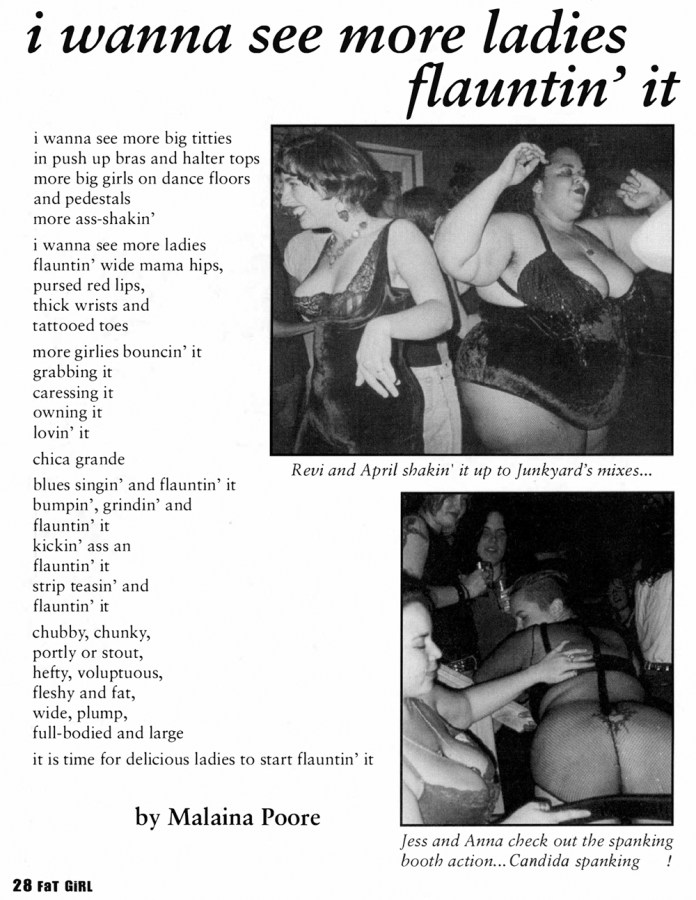
FaT GiRL is not just a vision of a fat, queer future, but also a valuable glimpse into queer culture at a very specific place and time — the Bay Area of the early 1990s, which is where our story begins. The local zine culture, spurred by the punk and queer communities, was exploding. Barbarism, who would later become a founding member of the FaT GiRL collective, and her partner at the time, EQ, decided to submit photos to Inciting Desire, a Santa Cruz-based queer erotica zine. They were rejected because of their size.
“There were all sorts of fat queers in leadership areas of the queer community,” she says. “We weren’t on the fringes. We were the favorite DJs in town, in bands, starting different organizations, but the fat hatred, both internalized and externalized, at the time wasn’t really being challenged.”
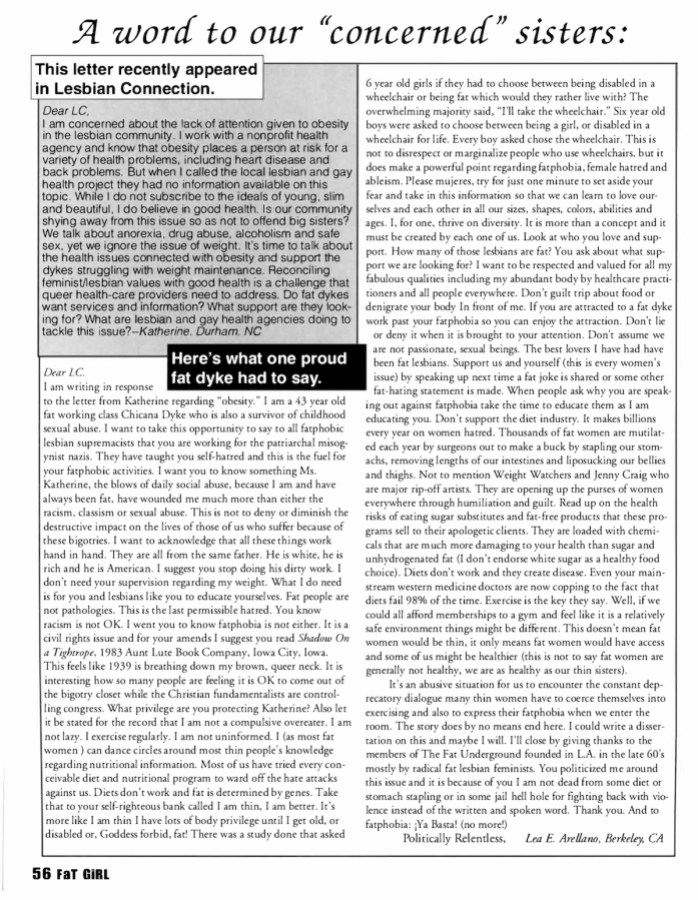
Later, sometime in 1993 or 1994, Barbarism, her lover at the time, Max Airborne, and Max’s friend Heather McAllister, were at a bar in the Castro discussing the exclusion of fat people from this queer and kink media scene. The solution? Make their own zine, which they’d call FaT GiRL. The original zine ran for seven issues between 1994 and 1997, and thanks to an initiative led by Airborne and other collective members, with the support of volunteer transcribers, captioners, and more, all seven issues have been digitized and are available online for free, part of the Fat Liberation Archive.
“This was a noninstitutionalized reaction,” Barbarism says. “This was political, intentional, we’re gonna be fat and queer and creative and sexy and empowering and a collective action.”
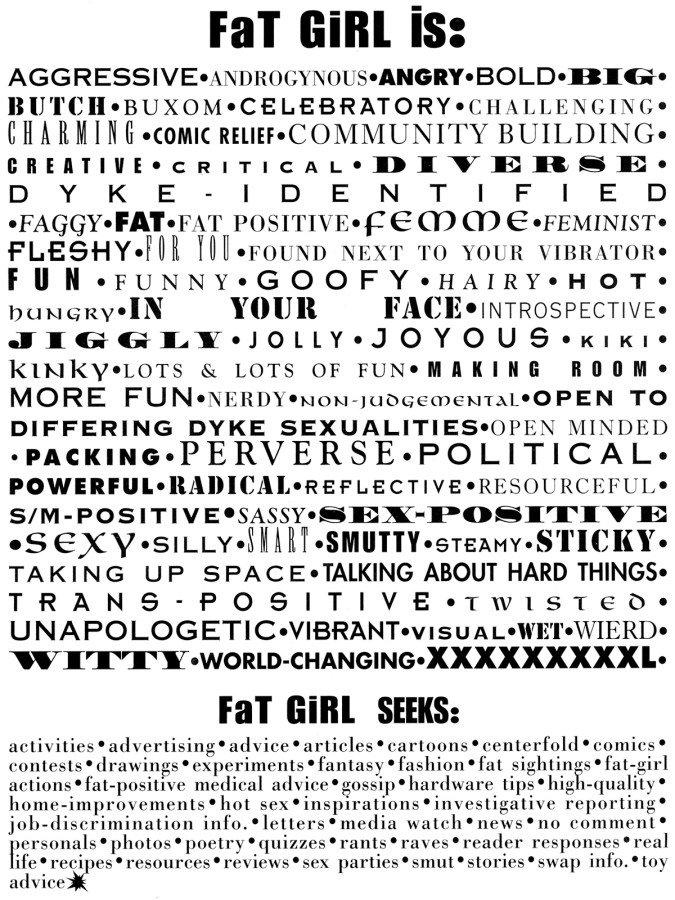
Even in the collective’s home of the Bay Area, FaT GiRL has been left out of queer, fat history. In 2019, when the Oakland Museum of California held an exhibition on untold stories of queer people in California, complete with a zine section, FaT GiRL was not included among the titles. It was that erasure, and the desire to preserve, that motivated Airborne to start the Fat Liberation Archive and digitize FaT GiRL. “If we don’t do something to prevent our erasure, it will be sealed,” Airborne says.
As an organizer and a researcher, Gelfand says they hope FaT GiRL will inform the way people will think and write about fatness, and allow young queer people insight into the work that came before, especially as young queers still rarely have access to queer elders. “Without our ability to access our own histories, we have to reinvent the wheel all the time,” Gelfand says. “There’s so much to be learned from this particular snapshot and window into history. It’s so wonderful for it to be accessible to people to inform their own movements and zines and cultural productions.”
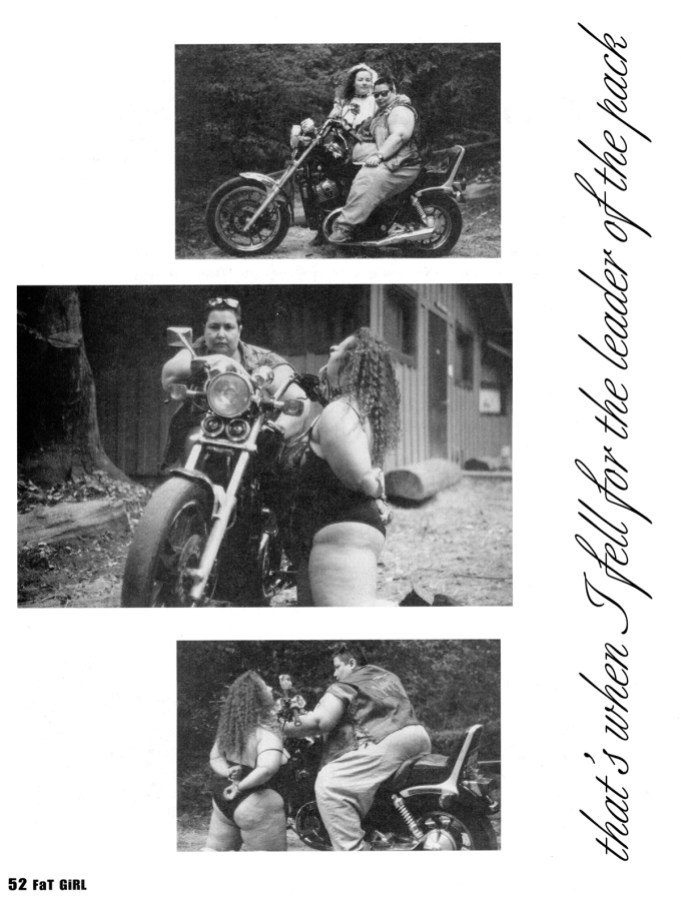
“My favorite part of FaT GiRL is the way in which it allows for endless multiplicities of fat personhood,” Gelfand says. “They just wanted everything, and very explicitly said, ‘Send us your erotic photos. Send us your rants. Send us your resource gathering.’ And it just created this space that allowed people to be their whole selves and that is so, so rare even now when it comes to fat people in the media. They created the world that they wanted to see both on paper and in the community in San Francisco and I think it allows you to see yourself as possible and sexy and funny and intelligent, and not see any of those things as individual identities or subjectivities. The same people who are naked on the centerspread are writing brilliant articles two pages later.”
The writing in FaT GiRL runs the gamut from vivid, fantastical erotica to political essays to tender, affirming poetry. Airborne began sharing stories and expressing themself through comics. An important element of FaT GiRL was the roundtables, where members of the collective could talk about their experiences and perspectives. And the zine included interviews with fat liberation luminaries like Judy Freespirit, the founder of the Fat Underground, and iconic lesbian author Dorothy Allison.
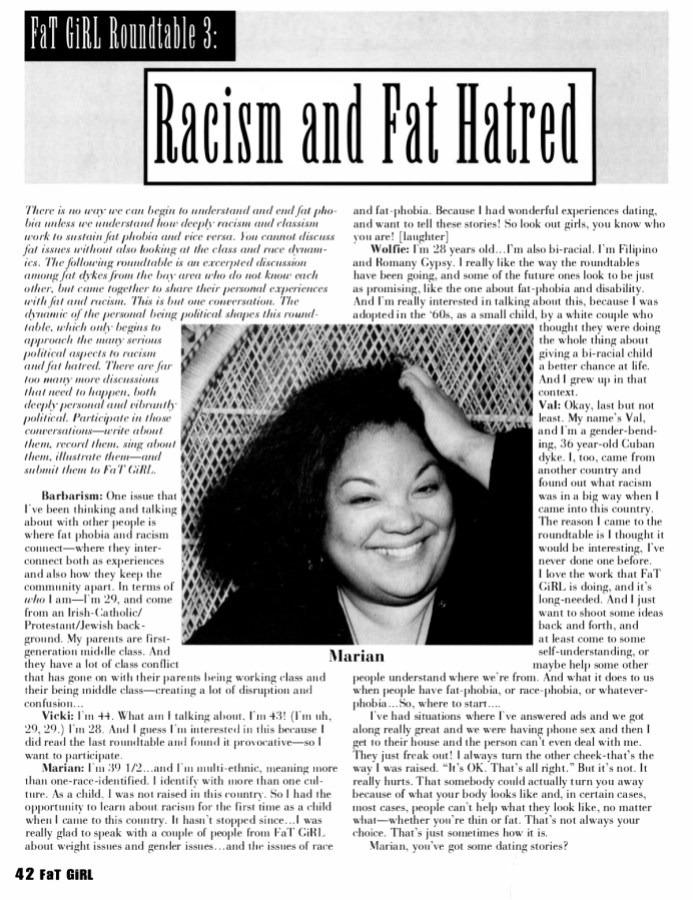
“I think one of the things that was really beautiful about doing the zine is we had an opportunity to interact with so many liberators in the community that were role models for us,” Barbarism says. “That’s a thing that’s really exciting about the fat archives themselves, the continuity and the connection.”
Barbarism says another takeaway from the FaT GiRL archive that she hopes new readers appreciate, especially in our hyper-individualized world and the age of the celebrity activist, is the power of the collective, of people working together. “I think it’s an important story to not lose, there’s power in the collective, working together,” Barbarism says. “You can reach a lot more people. And I love the new queer fat liberation activists that are creating influencer names for themselves, but I do feel like the collective is equally if not more important, and when you make a lot of room, you make room for everybody. I think that’s really integral to any future liberation.”
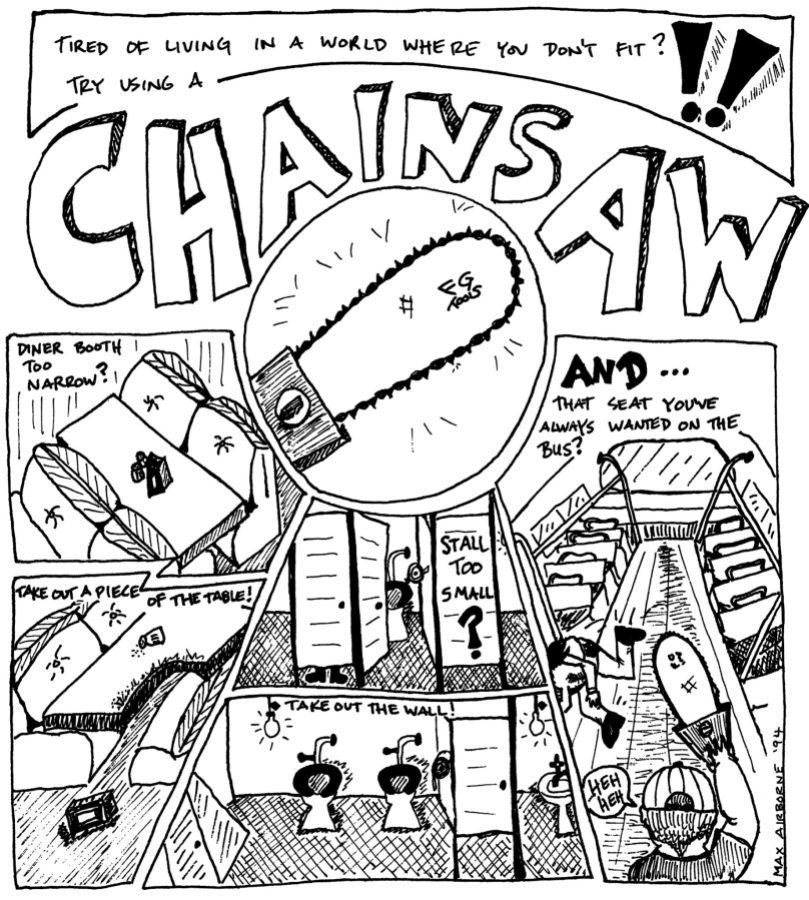
That collective spirit endures in Fat Rose, co-founded by Airborne, which seeks to organize a strong fat liberation movement in community with other social movements, including disability justice and prison abolition, as well as mutual aid efforts centering fat folks.
Airborne says the Fat Liberation Archive was initially just intended to be a digitization of FaT GiRL, but it quickly grew beyond that to preserve even more fat liberation related material. They say they’re working on an oral history component to the archive and have begun doing interviews over Zoom, which they will need support in transcribing and editing. The excitement over the project has brought archivists “out of the woodwork,” too. “Archiving is political,” Airborne says. “Archivists spend their lives working to preserve and promote the stories they’re trying to archive, stories that might be forgotten. We have such a deep responsibility to figure out how to tell and support the telling of people’s stories.”
Gelfand says it was beautiful to have so many people’s hands in the archival project and image description process, how people who had previously never had access to this work really spent time, contended with, and confronted the material thoughtfully. That’s not to say it’s without challenge — Airborne in particular has put in an incredible amount of labor, and estimates they did about 90% of the transcription themself. Time, sustainability, and preventing burnout are ongoing topics of conversation for the volunteers when they discuss the future of the archive.
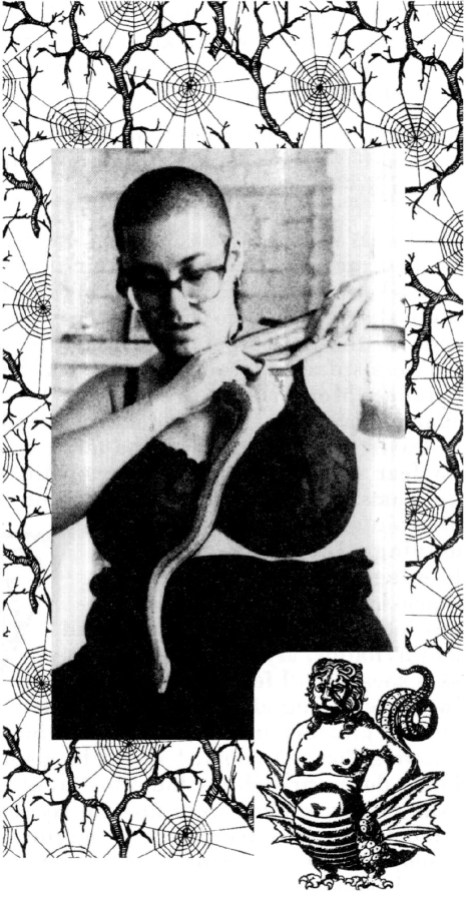
One of the other challenges in the digitization process so far has been reaching out to past contributors for permission to post their work on the archive. FaT GiRL’s contributors retained the rights to all their work, a radical notion even now, and led to Airborne contacting hundreds of people and their loved ones.
Airborne says as they were reaching out to contributors for permission to share their content for FaT GiRL on the archive, they realized how many of the original contributors were no longer living. They want the archive to serve as “living altars” to fat liberation-oriented people who have passed away (including those murdered by racist state violence and victim-blamed because of their fatness), and keep their work accessible to future activists, zinesters, and everyone else who can learn from it.
“So many fat activists get old or die and their collection of writings and correspondence and photos and fliers are in a box at Yale,” Airborne says. “I am never going to travel to Yale, so I and millions of people who might benefit from that will never get to see it. I’m really committed to [Fat Liberation] being a digital archive that remains accessible freely to everyone, I don’t want it to just benefit academics. I want it to benefit activists and people trying to do the work of fat liberation.”
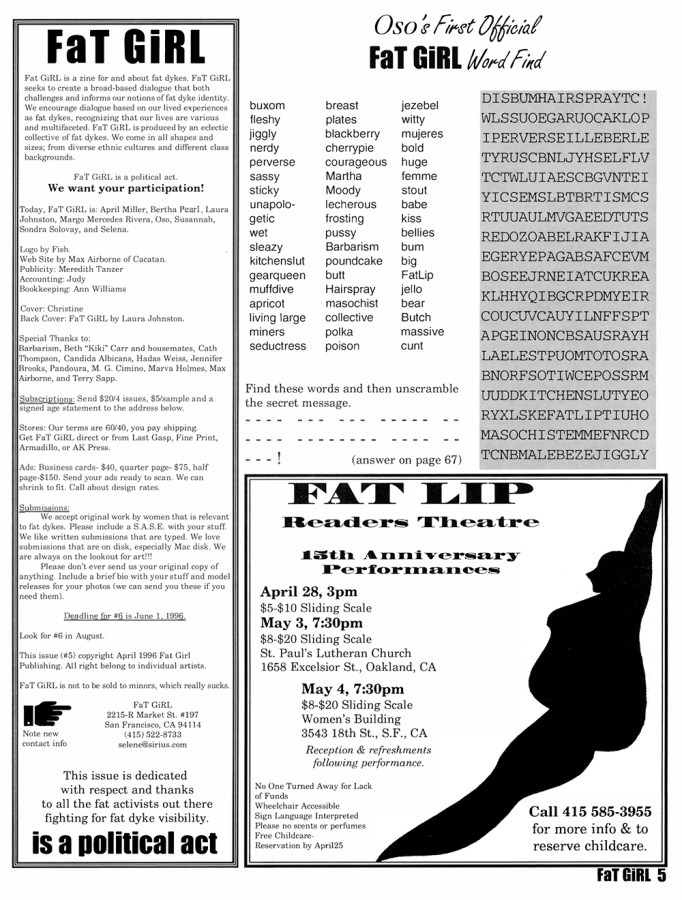
Although the archive is useful for Fat Studies as an academic discipline, the emphasis from Airborne is on the archive as a work of the people. One thing Gelfand discusses in her thesis is the documented story of fat activism so far is overwhelmingly white. “We not only have to just archive what exists, but we have to be critical of why that is the record,” Gelfand says.
Airborne and Barbarism also emphasized the need for an intersectional approach and urged people to “leave their silos.” “It feels so much bigger than fat queer people,” Airborne says. “I think we’re really learning about the ways that fat and fat hatred are deeply intertwined with the history of white supremacy and colonialism and things that are much bigger than just fatness. There’s an urgency to opening up our view and our work to bring the understandings together around ending white supremacy, around ending capitalism. Those things are so key to ending fat hatred, ending ableism, ending classism. The sooner we weave those into our work, the sooner we will be free.”
With new items arriving all the time for the archive, Airborne says they need support with transcription and writing image descriptions to expand the archive, as well as help creating more programming and curation around the archive and what’s in it. Locals to the Bay Area can also help with scanning new material for digitization. And most importantly, the archive is meant to be a people’s archive and they want everyone committed to fat liberation to be included in the process — Barbarism and Airborne emphasized that everyone’s writing, art, recordings, flyers, and more dedicated to fat liberation is welcome.
“Your big, fat voice matters and it’s up to you to bring it,” Barbarism says. “That’s the truth of all activist history. It’s that momentum when you recognize and realize you’re the doer, get out there and start doing. And when you do, you won’t be doing it alone, to do so with connection, whether it’s on a couch or in a bar, virtual or in-person. There’s so many ways you can show up today, and you show up to the best of your ability, and you show up again.”
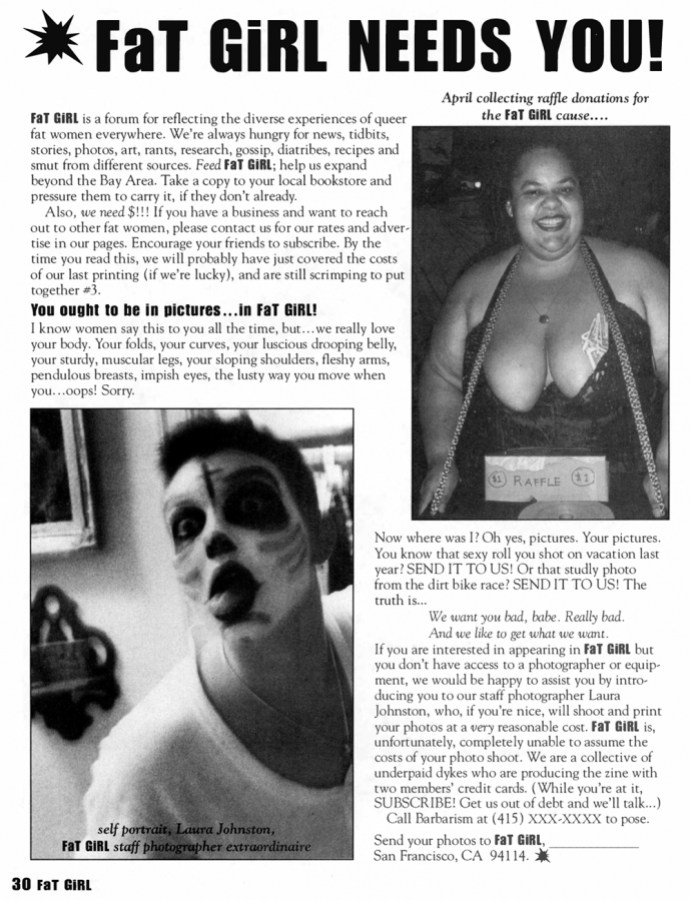



This is truly incredible – thank you.
This content is exactly why I am an A+ member. This was so good, so well-researched, and makes this fat queer lady so fired up. Thank you for such an excellent piece, Lindsay!
I love this and am really excited to dive into the links you’ve provided. Thank you for this piece!
Great article!
I had an almost-full run of this zine (I bought it off of the official Etsy, when they had one), but gave it to a friend for a grad school project. Still miss it, glad to see it archived for all!
Love this! Great reporting
What a beautiful article and zine.
Oh this is such a great find/share!! I’m already into the second one!
It kind of makes me sad that fat liberation folks are still talking about/working on the same things almost 30-50 years later…goodness.